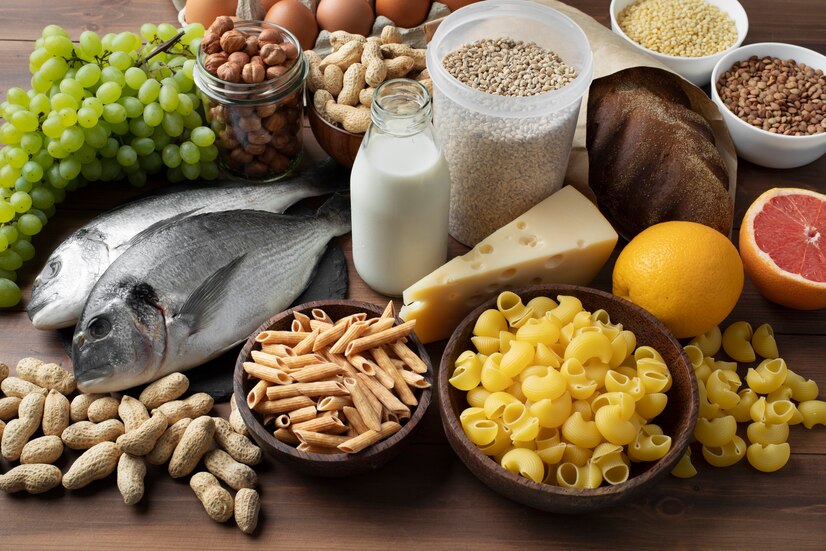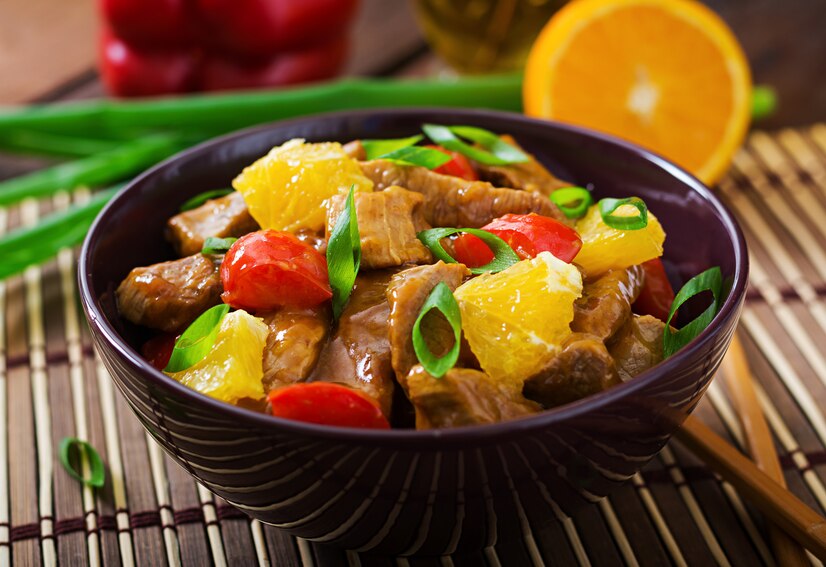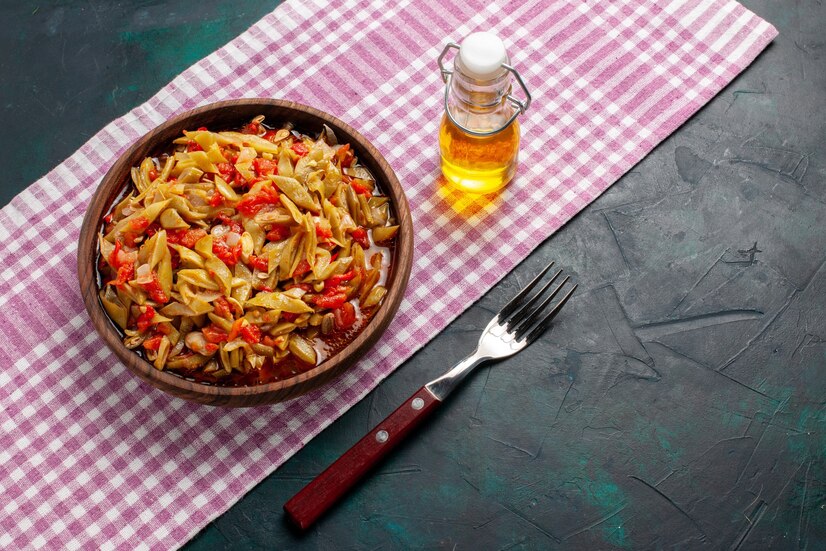
Healthy meals for the week
Healthy Meals for the Week recipes are handpicked for nutritious, delicious meals for four people during a work week, using the most affordable ingredients and ideas for utilizing leftovers. We’ve included a balance of lean proteins from meat, fish, dairy, and plant-based foods, as well as energy-boosting carbohydrates and healthy fats, including omega-3s, which are important for energy.
The ingredients in Healthy Meals for the Week recipes are rich in minerals essential for growth and development, such as iron, zinc, and calcium, as well as vitamin D and selenium, which can often be lacking in modern diets. Kids usually have difficulty eating certain foods, such as vegetables and fiber-rich grains, so these recipes Healthy Meals for the Week use clear techniques to incorporate them into sauces and stir-fries.
Want more inspiration for budget-friendly family meals? For more family meals that work for you, explore our Healthy Family Recipes and our Healthy Meals for the Week. We can find many pocket-friendly recipes and cooking tips in our main budget section. Are you worried about the cost of living? The Money Health Check Tool is free and can help anyone looking for ways to save money.

Healthy meals for the week:
On Monday:
Breakfast: Porridge made with skimmed milk and topped with banana slices.
Lunch:
- Sauté chicken, leeks, and brown rice.
- Stir in chicken, kale, bell pepper, and brown rice.
- Use yesterday’s roast chicken with smoky chorizo and soy sauce in our Quick Chicken, Leek, and Brown Rice Stir-Fry. Ready in just 20 minutes, it’s perfect for busy weeknights and can easily be adapted with extra veggies left in the fridge.
Chicken is a good source of the amino acid tryptophan, so choosing chicken in the evening will help boost serotonin levels and promote a good night’s sleep—especially important for school the next day.
Kale is an excellent source of vitamins C and E and may help with bone health and protection against heart disease.
Pouches made from whole grain rice reduce cooking time and increase your fiber intake.
Budget Tip:
This Healthy Meals for the Week is perfect for raiding the fridge, so take advantage of any leftover vegetables. We used low-salt soy sauce to reduce the sodium content.

Lentil Soup: Try lentil and vegetable soup, canned, or our easy carrot and parsnip soup recipe. Serve with two slices of wholemeal bread with spread (a spread based on vegetable, olive, or sunflower oil is unsaturated and is a better choice for your heart than butter).
Dinner: A medium jacket potato (cooked in the microwave or oven) with a tin of sardines in tomato sauce, served with peas.
Snacks: Two satsumas (or similar citrus fruits), an apple, a handful of unsalted peanuts (30 grams), and one serving (125 grams) of fat-free Greek-style yogurt.
On Tuesday:
Breakfast: Two slices of whole grain toast with spread, a boiled egg, and a sliced medium tomato.
Lunch:
- One-pan Spaghetti:
A quick and easy one-pan pasta with meatballs that saves on washing time and makes the most of pantry staples like diced tomatoes and dried pasta. In addition to being low in calories, it’s a source of vitamin C and counts toward two of your daily five. To reduce fat, if possible, choose lean beef or turkey meatballs.
Beef is a rich source of the minerals iron and zinc are both essential. essential for growth and repair, especially in childhood. Zinc helps us stay healthy by keeping our immune system functioning well and promoting the healing of cuts and wounds. Getting enough iron from your diet is especially important for teenage girls because they are often low in this important mineral, which can lead to feelings of tiredness and a lack of energy.

- Swap spaghetti for pasta shapes. They are easier for little ones to handle, which minimizes wastage.
- Chunky Vegetable Goulash:
Homemade chunky vegetable and bean goulash, served with brown rice. If you made the recipe earlier, use leftover carrot and parsnip soup, or freeze any extra for later use. Serve with two slices of wholemeal bread.
Dinner: Homemade chunky vegetables and bean goulash with brown rice. Get our Broccoli Goulash recipe.
Snacks: A small handful of unsalted peanuts, a carrot cut into sticks, and two satsumas (or easy-to-peel citrus fruits).
On Wednesday:
Breakfast: No-added sugar muesli with skimmed milk, topped with banana slices.
Lunch:
- Chickpeas with Cumin Rice and Raita:
Make this flavor-packed chickpea curry for a satisfying vegetarian meal that counts toward two of your five-a-day. It’s a great fallback if you don’t have time to shop, as it uses pantry staples like canned chickpeas, dry rice, and spices. Served with cumin-spiced rice and chilled cucumber raita, it’s full of exciting flavors and textures, and you can easily adjust the spice level for youngsters.
Beans and pulses, like chickpeas, are rich in protein, resistant starch, and soluble fiber, which help speed up digestion and lower blood sugar levels. This means they have a low glycemic index (GI) and release their energy more steadily, which is convenient for families with high energy needs.
Budget Tip:
If you’re short on time to make raita, adding a dollop of Greek or natural yogurt can serve as a cooling accompaniment to balance out the curry powder. Scattering with pomegranate is optional, but the dish is delicious on its own if you want to keep costs down.
Serve with half a can of low-sugar, low-salt baked beans and a portion of salad.

Dinner: Beetroot Barley Risotto, served with peas.
Snacks: A carrot cut into sticks, a handful of unsalted peanuts, and two satsumas.
On Thursday:
Breakfast: Two slices of whole-grain toast with a spread, sliced or mashed banana, and a serving of fat-free Greek-style yogurt.
Lunch:
Sesame and Spring Onion Stir-Fried Udon with Crispy Tofu
A bowl of udon noodles and stir-fry tofu with green beans. Make a quick and delicious vegan stir-fry in just 20 minutes. This low-calorie dish combines crispy tofu, fresh spring onions, green beans, and thick udon noodles with crunchy sesame seeds, offering plenty of exciting textures. We used low-salt soy sauce to provide a hint of umami flavor without increasing sodium levels too much.
Tofu is a popular plant-based meat and dairy alternative derived from soy, providing a rich source of ‘complete’ plant protein. It also contains natural compounds called isoflavones, which are powerful antioxidants, support heart health by lowering cholesterol, and may help relieve menopausal symptoms in women.

Budget Tip:
Shopping for a balanced plant-based diet shouldn’t be more expensive than a non-vegan diet. Supermarkets often have their own branded versions of meat and dairy alternatives.
Whole Wheat Spaghetti with Sardines and Tomatoes:
Egg, tomato, and cucumber whole wheat sandwich.
Dinner: Whole wheat spaghetti with sardines and cherry tomatoes, served with a portion of salad.
Snacks: Two plums, two oatcakes with spread, and a pear.
On Friday:
Breakfast:
No added sugar muesli with skimmed milk and a banana
Lunch:
Chicken and New Potato Trek
Our chicken and new potato trek is a fuss-free, easy, and cost-saving way to enjoy your Sunday roast – just cook chicken thighs and Jersey Royals in a pot, and combine olives, lemon, garlic, and bay leaves. Chicken thighs also take less time to cook in the oven than a whole roast bird, saving fuel.
Chicken is a great nutritional option, as white meat is generally lower in fat than red meat such as beef or lamb. It also provides a source of quality protein, which is essential for growth and development and is especially important for children and adolescents.
Potatoes, especially new potatoes, are a great affordable option and provide a good source of vitamin C. Encouraging younger family members to eat their vegetables can often be a challenge, and even though potatoes are a starchy food, that doesn’t mean they shouldn’t be part of the meal. While fruits and vegetables don’t count as a portion, their contribution to our vitamin C intake makes them plate-worthy.

Budget Tip:
Double the number of chicken thighs so you have some leftovers for tomorrow’s meal. We recommend making the most of the oven by cooking a large tray of roast cauliflower and squash, which you can serve as a side, and using the leftovers for lunch Healthy Meals for the Week.
Cheese Salad Sandwich: Made with low-fat cheddar, salad, two slices of whole-grain bread, and spread.
Dinner: Homemade mushroom and cauliflower frittata, served with peas and carrots or any other leftover/surplus vegetables.
Snacks: Two plums, two oatcakes with spread, and a pear.
On Saturday:
Breakfast: Porridge made with skimmed milk and a banana.
How healthy is your breakfast? We rank popular cereals from best to worst.
Lunch:
Turkey Burger
Five turkey burgers topped with flavor. Dried apricots may seem like an unlikely ingredient in these easy turkey burgers, but they help keep the burger juicy and moist while also adding extra flavor.
The sweetness of apricots will win over even the pickiest eaters, while also providing extra fiber and iron, and counting as a portion of fruit. Turkey is not only lean meat but also rich in immune-friendly minerals, selenium, and all B-group vitamins.
Adding oats to these burgers helps the meat go further and makes them more filling—just remember that young tummies can’t handle a lot of fiber, so the amount varies depending on the age of your kids. Oats are an excellent source of slow-acting carbohydrates, which help stabilize blood sugar levels.
These burgers are lower in fat if they’re finished in the oven instead of being fried or grilled.

Budget Tip:
Using thigh mince instead of breast mince costs less. However, slightly higher in fat, dark thigh meat is rich in minerals, including iron and zinc. You’ll notice different vegetable features throughout Healthy Meals for the Week, so buy loosely and in bulk to keep costs to a minimum.
Baked Tuna and Sweetcorn Pasta:
Try our delicious recipes for vegetable soups and canned or mixed vegetable and bean soups.
Dinner: Homemade tuna and sweetcorn pasta bake, served with cauliflower and broccoli.
Snacks: Salted peanuts, an apple, a pear.
On Sunday:
Breakfast: A portion of boiled egg and cooked mushrooms, with two slices of wholemeal bread.
Lunch:
One-Pot Coconut Fish Curry
NHS guidelines recommend that we should eat at least two portions of fish a week, with at least one being an oily variety such as salmon.
Fresh fish can be expensive, so we kept costs low in this easy one-pot coconut fish curry by using frozen fish pie mix instead. Ready in just 30 minutes, this one-pan dish is ideal for quick family meals on a budget.
Frozen fish pie mix usually contains a mixture of cod, salmon, and smoked haddock. Salmon is an excellent source of omega-3 fatty acids, which are believed to contribute to a healthy heart and help maintain skin, joint, and hormonal balance. Cod and haddock are high in protein, low in fat, and good sources of vitamin B12, which is essential for energy and nervous system support and may help prevent depression.

Budget Tip:
In addition to using frozen fish, we made the most of frozen peas, which often have a higher nutritional value than their fresh counterparts and are also good value. Canned coconut milk is another inexpensive ingredient that adds richness to this recipe without significantly increasing the fat content.
Chicken and Vegetable Trebak: Chicken and vegetable streak; baked apples and low-fat custard or homemade custard made with low-fat milk.
Dinner: Chicken, cucumber, and tomato whole sandwich (using leftover Trebak from lunch).
Snacks: A small handful of unsalted peanuts; cut carrot sticks; two satsumas (or easy-peel oranges).
Healthy Foods to Focus On:
- Unsaturated oils, such as avocado oil and olive oil.
- This list of foods provides some nutritious options to include in your routine but is not exhaustive:
- Fruit
- Vegetables, both starchy and non-starchy options
- Whole grains, including quinoa, oats, whole wheat products, brown rice, and more
- Dairy foods, especially low-fat dairy and fermented dairy products, such as yogurt, cottage cheese, and kefir
- Lean protein
- Eggs
- Legumes (beans and lentils)
- Soy, tofu, edamame
- Fish and shellfish
“Why is this meal plan great for you?”
We set this plan at 2,000 calories per day, which the Department of Agriculture lists as the estimated average calorie requirement for people aged 14 and older. Since 2,000 calories is the generally accepted average calorie requirement, it is also used on nutrition labels to calculate the percentage of the Daily Value of the listed nutrients.

Individual calorie needs vary based on muscle mass, exercise, age, and body size. To accommodate different needs, we vary calories between 1,800 and 2,200 calories per day, but you may need further adjustments based on your individual nutritional and energy needs.
Like all meal plans, it’s meant to serve as a template for a healthy eating routine. Feel free to adjust to fit your lifestyle, such as swapping out meals or snack options or choosing leftovers.
Frequently Asked Questions
Is it okay to mix foods in this plan?
“Is it okay for me to eat the same breakfast or lunch every day?”
Do I have to count calories to eat healthy?
Fiber: A Nutrient of Concern
Fiber is a crucial nutrient that offers numerous health benefits, such as enhancing digestion, regulating blood sugar levels, and promoting heart health. Also, fiber has staying power, meaning fiber-rich foods help us stay full between meals.
Unfortunately, many of us fall short of our daily fiber intake, with only 7% of Americans meeting their daily fiber goals. As a result, the 2020-2025 Dietary Guidelines for Americans have identified fiber as a nutrient of public health concern. Fiber is found in fruits, vegetables, beans, lentils, and whole grains, such as oats, whole wheat products, and bulgur.

The USDA lists the daily value of fiber as 28 grams for a 2,000-calorie diet. On this plan, you’ll get at least 29 grams of fiber each day, with a little extra on most days to help you reach your fiber goal.



Leave a Reply